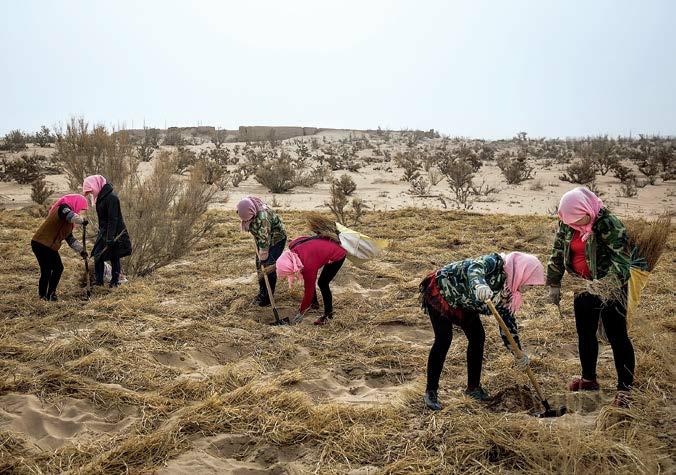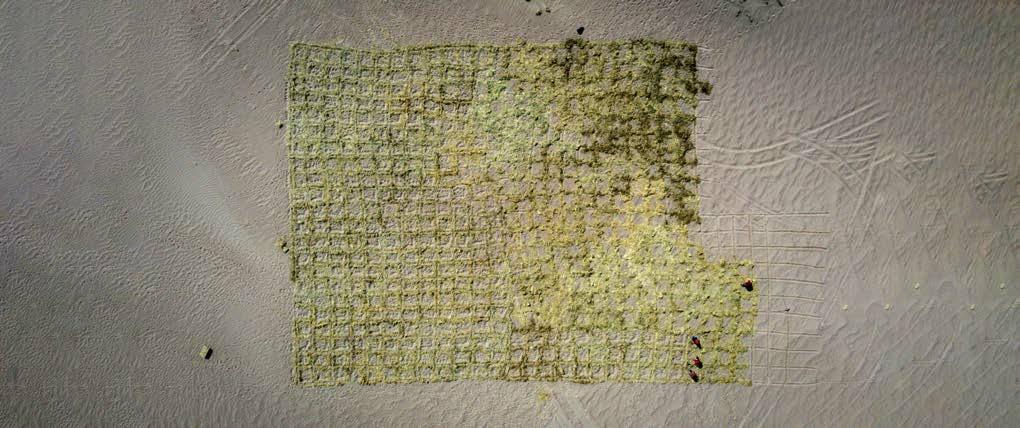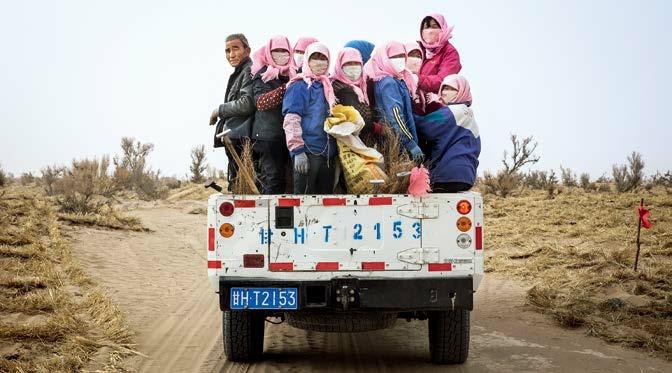Greening the Desert
2019-12-27byWangHe
by Wang He



On a map of China, the awkward geographic location of Minqin County is clear. The small county in Wuwei City, Gansu Province, is surrounded by Chinas third largest desert, Badain Jaran, and fourth largest, Tengger, from east, west, and north. The county has a total area of 15,900 square kilometers, of which deserts and various desertified land areas account for 90 percent. Facing such natural adversity, Minqin County, with a resident population of less than 250,000, has marched to the forefront of Chinas desertification monitoring and control.
Historically, Minqin was an oasis in the middle of the desert with abundant water and grass for fishing and grazing. After two large-scale population migrations involving people from other parts of China settling there and reclaiming wastelands during the early Ming Dynasty(1368-1644) and again during the reign of Emperor Yongzheng (1678-1735) of the Qing Dynasty (1644-1911), the fragile local ecosystem gradually deteriorated. By the 1950s, the glacial meltwater from the Qilian Mountains was significantly reduced, and the lake area was still shrinking. Minqin had become a lonely place in the sea of sand.
In 1959, China officially listed desertification in its western region as a major national issue for the first time. That same year, Minqin County established its first desertification control station. Over the following decades, the county spared no efforts to stop sand invasion. After painstaking endeavors across several generations, Minqin has now achieved early success in desertification prevention and control.
“Magic Tree” for Desertification Control
On a morning in March 2019 just after 7 a.m., 42-year-old Chen Yuxia put on a mask, wrapped her hair with a headscarf, put on her work shoes, and started her day planting trees in soft sand.
The area she plants is managed by the Shiyanghe Forestry Station in Minqin. The station was built in 1964 and remains the largest state-owned desertification control and forestation center in Gansu Province. “We need to put about 100 Haloxylon ammodendron saplings in the sand every day,” explained Chen,with a large bundle of saplings in her hands.
Haloxylon ammodendron is known as the ecological guardian of the desert area and considered a“pioneer of desertification control”by locals. The rhizome of adult Haloxylon ammodendron can reach as deep as four meters into the desert and its survival rate is over 90 percent. The tree helps block wind, fix the sand and improve the soil. Due to the special desert climate, the tree can only be planted in March and April, so those two months are the busiest time for Chen Yuxia and her tree-planting colleagues. Some villagers jokingly call Chen and her team the“tree-planting squad.”

Minqin people use straw checkerboard barriers for desertification control. They arrange low straw barriers in squares to help with wind prevention, sand fixation and water conservation, which have been proven conducive to growing Haloxylon ammodendron. The innovative method, which helps reclaim the desert inch by inch, has played an important role in desertification control. It was listed as one of the Global 500 Roll of Honor for Environmental Achievement by the UN Environment Programme.
Female Tree-Planting Teams
Liu Haiyan is a native of Xiaquan Village in Datan Town, Minqin County. As early as 2008, many of her fellow villagers were seriously concerned about desert invasion. Due to constant harassment from sandstorms, many of their backyards were often under piles of sand.“When the sandstorms were heavy, people could walk up the dunes onto their roofs,” recalled Liu.
Facing an urgent situation, Liu followed the call from the local government to join the tree-planting team for desertification control. There are many all-women tree-planting teams in Minqin, a phenomenon unique to the county. The Shiyanghe Forestry Station alone has as many as 30 all-female teams. Like Liu, most members of those teams are Minqin locals. With kids grown up and husbands either work in other places or busy with farming at home, the women have left home to become a major force of planting trees on sandy soil.
After a decade, a formerly sandy area near the village had become a lush grove of green Haloxylon ammodendron. Corn and sorghum were thriving in fields. “The sandstorms are much less furious now than before,” noted 48-year-old Zeng Ruiyin, the cook of the tree-planting team. As she spoke, she skillfully sliced noodles, a favorite staple for people of northwestern China, from dough before placing them into a boiling pot. In the past, she was constantly cleaning the kitchen because even a gentle breeze would blow dust and sand in. The situation has improved significantly in recent years. Minqins ecological environment has gradually improved as its afforestation project has advanced deeper into the desert.“If there are no strong winds, we can even make steamed buns and noodles in the desert.”
Today, the women of Minqin begin to plant trees soon after every Spring Festival. Over the years, desertification control efforts have enabled Minqin to gradually escape the fate of becoming a “second Lop Nur,” a former saline lake in northwestern China that is now only a salt-encrusted bed. According to statistics from the fifth desertification survey in Gansu Province in 2015, compared with the 2009 results, the desertified area and sanded area in Minqin had decreased by 4,173 hectares and 4,507 hectares, respectively. Qingtu Lake, which had disappeared for decades, has seen its underground water level rise by 1.08 meters in recent years, making it an attractive wintering ground for wild aquatic birds again.

Ecological Economics After the desert in Minqin began to come under containment, locals began testing methods to “dig gold”from the desert to capture both ecological and economic benefits at the same time. Desert-related industries emerged and attracted massive attention. The cultivation of Cistanche deserticola, a Chinese medicinal herb, emerged as a representative. Since 2011, Minqin has contracted desertification control forests out to individuals, enterprises and cooperative organizations to perform management, protection and operation. The industry of inoculating Cistanche deserticola on Haloxylon ammondendron has been encouraged and supported. Seizing every opportunity, many women from local tree-planting teams have participated in work related to the new industry through cooperatives.“It doesnt cost anything to get a contract project,” Liu illustrated.“We plant Cistanche deserticola under Haloxylon ammondendron, and we tend the trees.”
The desert industry soon enhanced locals incomes. In 2017, the population directly or indirectly engaged in desert greening and desert-related industries in Minqin reached 114,000, with a total output value exceeding US$45.53 million. The per capita disposable income of rural residents in the county reached US$1,591, of which 36 percent came from desertification control projects and desert-related industries.
The efforts and achievements of Minqin people in desertification control have guided Chinas expanding work on ecological protection in recent years. An article published by the journal Nature Sustainability on February 11, 2019, pointed that recent satellite data from 2000 to 2017 show a strikingly prominent greening pattern in China. Chinas efforts to conserve and expand forests are a key driver of the‘Greening Earth.”